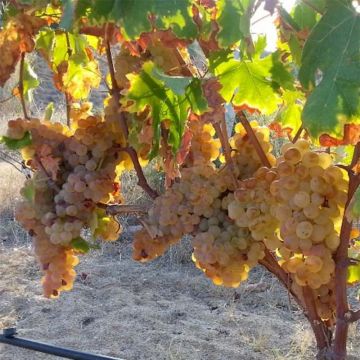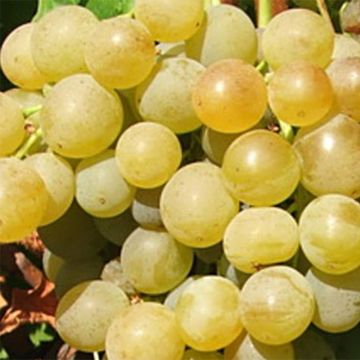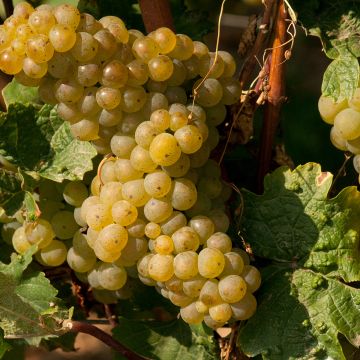

Vitis vinifera Palatina - Grape Vine
Vitis vinifera Palatina - Grape Vine
Vitis vinifera Palatina
Common Grape Vine, European Grape, Wine Grape
Special offer!
Receive a €20 voucher for any order over €90 (excluding delivery costs, credit notes, and plastic-free options)!
1- Add your favorite plants to your cart.
2- Once you have reached €90, confirm your order (you can even choose the delivery date!).
3- As soon as your order is shipped, you will receive an email containing your voucher code, valid for 3 months (90 days).
Your voucher is unique and can only be used once, for any order with a minimum value of €20, excluding delivery costs.
Can be combined with other current offers, non-divisible and non-refundable.
Why not try an alternative variety in stock?
View all →This plant carries a 6 months recovery warranty
More information
We guarantee the quality of our plants for a full growing cycle, and will replace at our expense any plant that fails to recover under normal climatic and planting conditions.
Description
The Palatina vine is a hybrid variety of Hungarian origin, with a fairly upright and vigorous habit, capable of reaching a height of 4m (13ft) when trained on a trellis or arbour. This variety produces sweet, golden-yellow table grapes with Muscat notes, which are ready to be harvested around mid-September. The clusters of medium to large, loosely packed berries are not very susceptible to major vine diseases. This vine thrives in most neutral to limestone soils that are well-drained and sunny. It is very resistant to cold temperatures and drought.
The wine grape (Vitis vinifera) grew wild over 5000 years ago in North and Central America, Europe, and Central and Eastern Asia. The subspecies sylvestris still exists, and it is a climbing vine that grows on the edges of forests and can reach great heights in trees. The current varieties, known as grape varieties, are classified under the vinifera subspecies (although there are other cultivated species, but they are very rare).
Palatina is a hybrid obtained through a cross-breeding performed in 1966 by three Hungarian breeders, between the Villard Blanc variety (credited to the Drôme-based company Seyve-Villard) and the Queen of the Vines (a Hungarian variety known by various names in different languages: Königin der Weingarten, Reina de la Vinas, Queen of the Vineyards, etc.).
This vigorous climbing woody vine with an erect habit can easily reach a height of 4m (13ft) and spread 3m (10ft) if not pruned. It needs to be trained on a trellis or arbour, which it can cover fairly quickly. Its foliage is a beautiful matte light green, with three or five-lobed leaves that are toothed along the edges. Like most grapes, it is self-fertile. Its flowering occurs in May-June, depending on the year and region, producing very small greenish hermaphroditic flowers.
These flowers develop into medium to large, loosely packed clusters. The berries are medium to large, oval-shaped, initially greenish-yellow and ripening to golden yellow, with a bronze hue on the side exposed to the sun. These fruits are ready to be harvested around mid-September. With a fairly thick skin that gives them a crunchy texture, these berries are sweet with a pleasant hint of Muscat flavour. This variety is highly resistant to diseases, particularly powdery mildew. It is advisable to perform summer green pruning to remove certain leaves so that the grapes are exposed to the sun and can develop their golden colour, which is a sign of their taste quality.
This vine is very hardy (to -25°C (-13°F)) and grows best in full sun, in neutral to limestone, even slightly acidic, well-drained soil. Ordinary soil, even rocky, is sufficient, as it is resistant to drought. Soil that is too rich, or excessive fertilization will promote vegetative growth more than fruit production. Simply provide organic fertiliser after harvest to store reserves for the winter. Your vine will use these reserves to start afresh in the following spring.
Palatina grapes can be consumed as table grapes or juice, for example in a vitamin-packed fruit cocktail for breakfast. In general, grapes are rich in vitamin B, a source of fibre and manganese, and they are well-supplied with antioxidants. They are also believed to play a role in preventing cardiovascular diseases, and above all, they are a healthy, natural, and delicious dessert. To create unique fruit salads, sow Peruvian Ground Cherry (Physalis peruviana) at the end of spring to harvest its amazing orange fruits from August to October. To enjoy grapes over a long period, plant other varieties of grapevines with staggered ripening times.
Report an error about the product description
Vitis vinifera Palatina - Grape Vine in pictures


Plant habit
Fruit
Flowering
Foliage
Botanical data
Vitis
vinifera
Palatina
Vitaceae
Common Grape Vine, European Grape, Wine Grape
Cultivar or hybrid
Other Grapevines
View all →Planting and care
Since the ravages of phylloxera at the end of the 19th century, the vine is normally grafted onto different resistant rootstocks adapted to various types of soil. These rootstocks come from American varieties naturally armed against this formidable parasite, itself of American origin.
Plant the Palatina vine in autumn, in deep, well-drained soil, even stony, clayey and limestone, knowing that the vine-plant is not demanding regarding the chemical nature of the soil. It is capable of thriving in moderately acidic soil (up to pH 6 approximately because below that, there are assimilation blockages of certain trace elements), neutral and limestone up to pH 8.5 approximately (in this case, it is the excess of active limestone that is detrimental).
Plant it in a sunny location, sheltered from strong, cold and dry winds. This variety can withstand winter frosts and is hardy down to about -25°C. Incorporate 3 or 4 handfuls of fruit tree fertiliser and 2 kg of composted manure for each vine into the planting soil. The roots should not be in contact with the manure. After planting, prune above 2 large buds (buds) to encourage the growth of two branches. Keep the most vigorous one and tie it to a stake. This will be followed by training pruning.
The vine does not require regular feeding for good yield, on the contrary. In overly rich soil, vegetation (leaves) will develop at the expense of fruiting. Enrich the soil with potash, bonemeal or iron chelate, only every 2-3 years.
This variety is highly resistant to classic vine diseases, including powdery mildew.
Planting period
Intended location
Care
This item has not been reviewed yet - be the first to leave a review about it.
Similar products
Haven't found what you were looking for?
Hardiness is the lowest winter temperature a plant can endure without suffering serious damage or even dying. However, hardiness is affected by location (a sheltered area, such as a patio), protection (winter cover) and soil type (hardiness is improved by well-drained soil).

Photo Sharing Terms & Conditions
In order to encourage gardeners to interact and share their experiences, Promesse de fleurs offers various media enabling content to be uploaded onto its Site - in particular via the ‘Photo sharing’ module.
The User agrees to refrain from:
- Posting any content that is illegal, prejudicial, insulting, racist, inciteful to hatred, revisionist, contrary to public decency, that infringes on privacy or on the privacy rights of third parties, in particular the publicity rights of persons and goods, intellectual property rights, or the right to privacy.
- Submitting content on behalf of a third party;
- Impersonate the identity of a third party and/or publish any personal information about a third party;
In general, the User undertakes to refrain from any unethical behaviour.
All Content (in particular text, comments, files, images, photos, videos, creative works, etc.), which may be subject to property or intellectual property rights, image or other private rights, shall remain the property of the User, subject to the limited rights granted by the terms of the licence granted by Promesse de fleurs as stated below. Users are at liberty to publish or not to publish such Content on the Site, notably via the ‘Photo Sharing’ facility, and accept that this Content shall be made public and freely accessible, notably on the Internet.
Users further acknowledge, undertake to have ,and guarantee that they hold all necessary rights and permissions to publish such material on the Site, in particular with regard to the legislation in force pertaining to any privacy, property, intellectual property, image, or contractual rights, or rights of any other nature. By publishing such Content on the Site, Users acknowledge accepting full liability as publishers of the Content within the meaning of the law, and grant Promesse de fleurs, free of charge, an inclusive, worldwide licence for the said Content for the entire duration of its publication, including all reproduction, representation, up/downloading, displaying, performing, transmission, and storage rights.
Users also grant permission for their name to be linked to the Content and accept that this link may not always be made available.
By engaging in posting material, Users consent to their Content becoming automatically accessible on the Internet, in particular on other sites and/or blogs and/or web pages of the Promesse de fleurs site, including in particular social pages and the Promesse de fleurs catalogue.
Users may secure the removal of entrusted content free of charge by issuing a simple request via our contact form.
The flowering period indicated on our website applies to countries and regions located in USDA zone 8 (France, the United Kingdom, Ireland, the Netherlands, etc.)
It will vary according to where you live:
- In zones 9 to 10 (Italy, Spain, Greece, etc.), flowering will occur about 2 to 4 weeks earlier.
- In zones 6 to 7 (Germany, Poland, Slovenia, and lower mountainous regions), flowering will be delayed by 2 to 3 weeks.
- In zone 5 (Central Europe, Scandinavia), blooming will be delayed by 3 to 5 weeks.
In temperate climates, pruning of spring-flowering shrubs (forsythia, spireas, etc.) should be done just after flowering.
Pruning of summer-flowering shrubs (Indian Lilac, Perovskia, etc.) can be done in winter or spring.
In cold regions as well as with frost-sensitive plants, avoid pruning too early when severe frosts may still occur.
The planting period indicated on our website applies to countries and regions located in USDA zone 8 (France, United Kingdom, Ireland, Netherlands).
It will vary according to where you live:
- In Mediterranean zones (Marseille, Madrid, Milan, etc.), autumn and winter are the best planting periods.
- In continental zones (Strasbourg, Munich, Vienna, etc.), delay planting by 2 to 3 weeks in spring and bring it forward by 2 to 4 weeks in autumn.
- In mountainous regions (the Alps, Pyrenees, Carpathians, etc.), it is best to plant in late spring (May-June) or late summer (August-September).
The harvesting period indicated on our website applies to countries and regions in USDA zone 8 (France, England, Ireland, the Netherlands).
In colder areas (Scandinavia, Poland, Austria...) fruit and vegetable harvests are likely to be delayed by 3-4 weeks.
In warmer areas (Italy, Spain, Greece, etc.), harvesting will probably take place earlier, depending on weather conditions.
The sowing periods indicated on our website apply to countries and regions within USDA Zone 8 (France, UK, Ireland, Netherlands).
In colder areas (Scandinavia, Poland, Austria...), delay any outdoor sowing by 3-4 weeks, or sow under glass.
In warmer climes (Italy, Spain, Greece, etc.), bring outdoor sowing forward by a few weeks.


























































